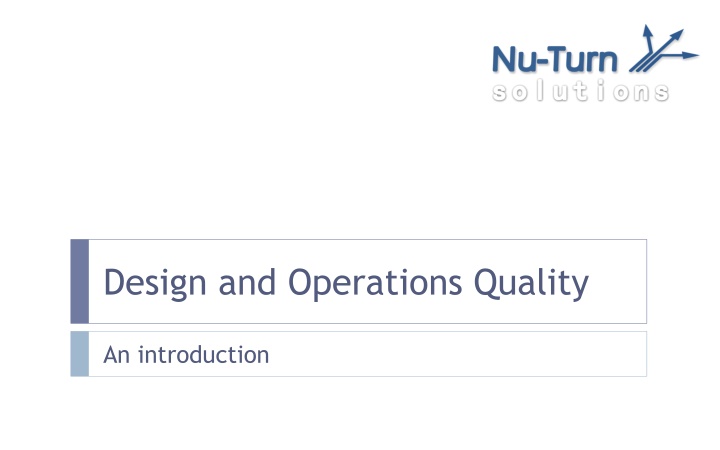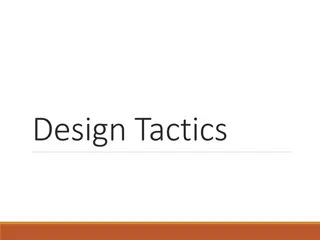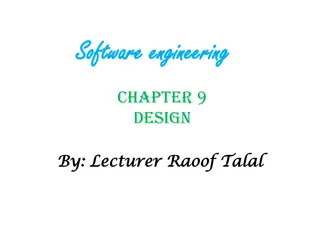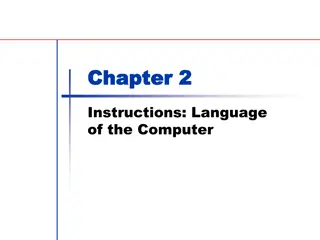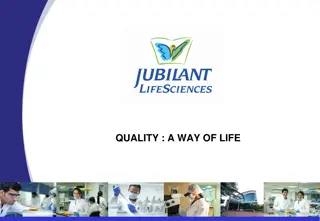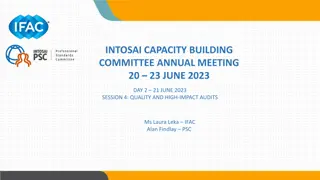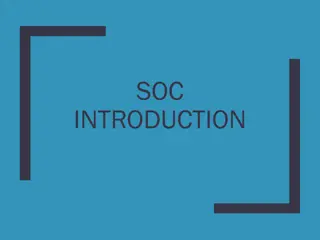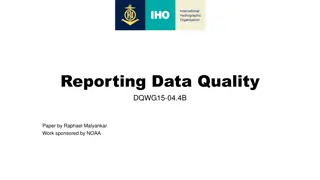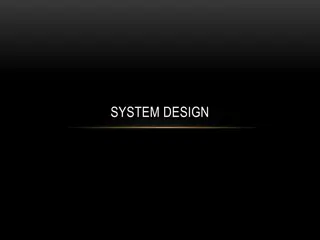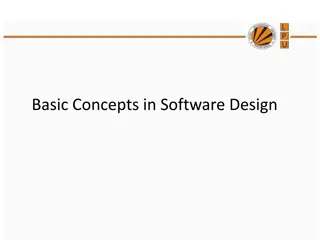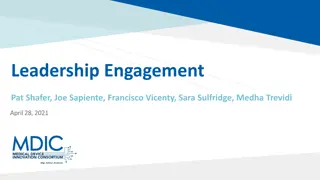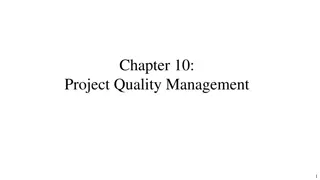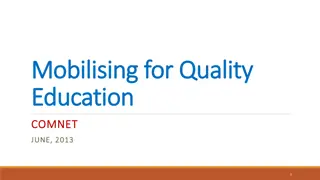Design and Operations Quality
Explore the fundamental principles of design and operations quality in this introductory guide. Covering essential topics such as quality management systems, process improvement, and performance metrics, this resource offers a comprehensive overview for professionals striving to enhance quality standards within their organizations. Gain insights into key strategies, tools, and approaches to drive quality excellence and operational efficiency across various industries.
Download Presentation

Please find below an Image/Link to download the presentation.
The content on the website is provided AS IS for your information and personal use only. It may not be sold, licensed, or shared on other websites without obtaining consent from the author.If you encounter any issues during the download, it is possible that the publisher has removed the file from their server.
You are allowed to download the files provided on this website for personal or commercial use, subject to the condition that they are used lawfully. All files are the property of their respective owners.
The content on the website is provided AS IS for your information and personal use only. It may not be sold, licensed, or shared on other websites without obtaining consent from the author.
E N D
Presentation Transcript
Design and Operations Quality An introduction
Quality gap analysis Customer perceived quality gap results from an additive effect of several organisational gaps: Gap 1: Listening gap: Not knowing current expectations, including legal and other stakeholder requirements, resulting in an imperfect perception of customer needs. Gap 2: Specification gap: Poor translation into design requirements. Misinterpreting the standards. Gap 3: Design gap: Poorly designed or under- developed product. Lacking solution. Lacking testing and validation. Gap 4: Operations gap: Inadequate resources and/or poor performance in the delivery system. 3 Frede Jensen
Integrating design and operations Customers experiences of quality depend on: 1) Product or service designed to match needs, and 2) Operations consistently producing and delivering the product as intended by designer. Operations will learn from own activities and the forever evolving customer feedback, thereby identifying opportunities for improvement to the original design. Design and operations are effectively elements of an integrated wider organisation, arranged around the Plan-Do-Check-Act cycle. Design and operations can occur in different organisations. ISO High Level Structure (HLS), incorporating QFD model, support common approach. 4 Frede Jensen
PDCA management cycle 5 Frede Jensen
Design Quality QFD model and ISO 16355-1 principles
Quality Function Deployment Approach to addressing the design element within wider system. Addresses all organisational issues identified by the gaps analysis. Coherently and systematically maintains in focus what is most important to customers and stakeholders, thereby assuring quality and reducing development time. Standard ISO 16355-1 on General principles and perspectives of Quality Function Deployment defines a generic design process flow chart, which includes the hand-over to operations. 7 Frede Jensen
QFD models ISO 16355-1, Annex A, indicates and summarily discusses example QFD models for different degrees of project complexity, where: Comprehensive model is suggested for large projects addressing many needs. German institute model is not well described, but appears to be a truncated comprehensive. 4-phase QFD is referenced as a truncated variant of the comprehensive. Blitz QFDTM is a 7-phase model corresponding to phases 1 and 2 of 4-phase QFD and is suggested for fast, resource constrained projects addressing only few needs. Internet image search indicates that 4-phase model is used in about 95% of all QFD today. 4-phase model is tailored and continually evolving. 8 Frede Jensen
Evolved 4-phase QFD model Truncated from comprehensive model. Continually evolving and tailored. Applicable to hardware, software, parts or services design. Our model here is one example of many. Each the 4 design phases consists of 2 steps: 1) Planning of phase specification. 2) Development against specification. Phases interlinking maintains integrity of customer and stakeholder requirements. 9 Frede Jensen
Project span Starting and ending points may vary. Examples: a) Organisation has well-developed market insight and platform solutions. This enables a shortcut in the VOC phase, by making it simply a matter of clarifying the existing data for the project and ensuring its visibility to the developers. b) The development may be a software product, for which the production process is already well-developed. It then suffice to use QFD approach phase 1 and 2 only. c) QFD project may omit phase 4 and instead hand the process specification to the production team under a program of Kaizen. 10 Frede Jensen
Project scoping When starting-up the design project we essentially seek clarity and communicate awareness about: Purpose of the project. Who the customers and stakeholders are, and what we aim to do for them. Who in the organisation influences the design or project context, and what their involvement in the project will be. Project time line. Allocated resources and aids. Responsibility and authority. 11 Frede Jensen
Voice of Customer Clearly define what customers and stakeholders need and what they want, and also understand what they could tolerate less of and what they do not want at all. Identify currently unmet needs. Use factual decision information - not isolated/minority opinions. Customers tend to express their wants , and are often not aware of or ambitious enough about their needs. Customers see their needs and wants mainly in relation to solutions they already know. New solutions that are too alien risk being rejected unless a strong brand. Designer sees the design problem in his or her individual way, which if done distantly can differ in perception to that of real customers. Designers must go through formal process of meeting customers and experience the new product s use environment. If VOC is wrong then everything that follows will be wrong! 12 Frede Jensen
Classifying Needs Line of indifference is a value point where customers are neither satisfied nor dissatisfied. Self-actualisation needs help people realise their personal growth potential. It relates to a sub-conscious meaning of life, to become the most complete self. Customers value highly. Excitement needs create an emotional engagement or unexpected spontaneous desire. Performance needs are what customers will ask for and against which they intent to measure their buying decision unless overruled by influence of an excitement or basic need. Value diagram combining Kano1) and Maslow2) 1) Kano, N., Nobuhiku, S., Fumio, T., Shin-ichi, T., "Attractive quality and must-be quality". Hinshitsu (Journal), Vol.14, No.2: 39 48, April 1984 Basic needs are threshold needs, taken for granted. Although not be asked for, their omission will result in rejection. 2) Maslow, A. H. (1968). Toward a Psychology of Being. New York: D. Van Nostrand Company. 13 Frede Jensen
Analytical Hierarchy Process Decision-making tool, by Thomas Saaty. Ranks priorities in situations that contain uncertainty or are complex by multiplicity. Decomposes the decision-making problem into simpler pair-wise comparisons between each of the candidate elements. Pair-wise comparison can be either qualitative (expressed in words) or quantitative (expressed numerically). AHP matrix can be scored in a team session, in a similar way to the QFD House of Quality matrix (see later). Judgement is objectively synthesised by mathematical processing, to produce the overall set of priorities. 14 Frede Jensen
Translation table Stimulates and compels the design team to think laterally. Presents alternatives for evaluation and selection, according to business plan ambition and difficulty budget (see next slide). Looking across and down the table can realise a duality from combining related functions into one multi-functional output requirement. What How 15 Frede Jensen
Planning Addresses, for the present phase: a) What source requirements are we to address? b) How should we go about addressing them? House of Quality matrix tool records and transfers the importance of characteristics in the input requirements (What) into the characteristics in the output requirements (How), establishing a prioritised plan for what to do next. Context weighting sets the ambition for the design project. As radical new or conservatively static as we need. What context defines the direction the organisation wants and needs to take, with regards to meeting the customer requirements. How context defines the degree of ambition, or necessary trade-offs, in term of workload and technical creation to be achieved. The business case, sponsoring the project, will normally have predefined the ambition and difficulty budget . 16 Frede Jensen
Correlation roof Correlation roof summarises the interdependences between the various hows . Positive correlation indicates an enhancement in one or both of the hows . Negative correlation means that the paired hows impede each other and that a design trade-off is required. Correlations can be used in three ways: Help define an appropriate trade-off position that bears relation to the transferred customer quality requirements. 1) Highlight an opportunity for thinking inventively, where clever solving of a conflict difficulty would help create a competitive advantage. 2) Show design aspects that are independent of each other and can therefore be developed concurrently; and the ones that are inter-dependent and therefore have pre-conditions to the plan for their development. 3) 17 Frede Jensen
Development Picture board. Translation table. Sketching. Design re-use. CAD modelling. Cost Function Analysis. TRIZ. Design for Manufacturing. Engineering optimisation. Rapid Prototyping, build and test cycles. Robust Engineering Design (RED). Failure Mode and Effects Analysis (FMEA). ... and many more 18 Frede Jensen
Cost-Function analysis Helps identifying cost-effective ways of satisfying design solutions. 19 Frede Jensen
Concept selection Best score Decision-matrix method, by Stuart Pugh, for comparing alternatives. 20 Frede Jensen
Robust Engineering Design Method for using statistical experimentation to determine the response effects from changing the controllable design factors, under varying conditions of normal uncontrollable noise factors. Analysis will find that varying the operating point for an individual design factor tends to have one of the following effects on the response: No effect. Dispersion in consistency of response. Moving the mean of response. Dispersion and mean (points 2 and 3 simultaneously). Aim is to find a combination of design factors that produces a system response at the desired target location, with the least or a tolerable dispersion under normal variability of operation i.e. robust to noise. Fix monomer ratio Mb Fix lamp intensity Lb Adjust thickness by exposure time 21 Frede Jensen
FMEA Tool for analysing potential failures and their effects, and for evaluating the development of countermeasure to prevent these effects from being realised in the design or in the related operations processes. 22 Frede Jensen
Design validation Post-development testing to establish evidence for conformance of the design output to input requirements. Last chance for catching unforeseen design shortfalls. V-model visualises relationship link between the requirements and testing activities that verifies the result through: Functional validation Reliability evaluation Risk evaluation Example V-model. It may vary for different products and industry sectors. Requirement validation 23 Frede Jensen
Operations Quality ISO 9001 quality management model
Quality Management System ISO 9001 High Level Structure model, containing 5 system elements 25 Frede Jensen
Functional vs process approach Optimisation result within a functionally divided organisation Optimisation result within a process-approach We all belong to both a functional structure and to a process structure. Everyone must integrated their efforts, with focus on the customer at the start and end of the core process. 26
Process Approach End-to-end process approach enables the organisation managing the system and its value creation as an integrated whole, including the risks and opportunities: Risk-based thinking means to ensure that risks are identified, considered and controlled by a proactive approach. Integrated process-based organisation Opportunity is defined as a set of circumstances that makes it possible to do something positive. Process is an activity or set of activities using resources, and are managed to enable the transformation of inputs into outputs . Process approach refers to the systematic definition and management of processes and their interactions so that to achieve the intended overall results in accordance with policies and strategy direction Single process model (adapted from ISO 9001:2015) 27 Frede Jensen
Processes definitions Hierarchical structure: Level 1 Organisation s purpose, relating to customer, interested parties and legal requirements. Level 2 Structure of core processes, relating to Level 1 requirements and also incorporate the ISO High Level System model elements. Level 3 Individual processes and sub-processes, relating to Level 2 structure and also reflect the single process model. Level 4 Records and evidence produced from the system should meet requirements for governance and traceability. Hierarchy is not mandatory, but supports clarity. 28 Frede Jensen
Lean Principles Systematic iterative approach to identifying and eliminating waste, through a continual perfecting of the work flow to the pull demand of the customer. Value added activities are those that are worth paying for having done. Non-value added activities are those that nobody can see any worth in paying for. Non-value added required are those that do not add value but must be done say, for legal safety reasons. Targets 8 wastes: Inventory Transportation Motion Waiting Defects Over-processing Over-production Under-utilisation of resources 1) 2) 3) 4) 5) 6) 7) Usually, only 5% to 30% of activities time and effort truly adds value 8) 29 Frede Jensen
Process Validation Collection and evaluation of data in order to judge whether there is sufficient understanding to have a high degree of confidence in the process. Stage 1: Process design, during which knowledge of the risk factors and a strategy for their control is established (e.g. by FMEA). Some process quality attributes are inherited from product design i.e. the design robustness to process variability will determine the attention to tolerances and controlling that is required. Stage 2: Process qualification is the validation of facility and equipment installations (IQ); operational stability, capability and sensitivity (OQ); and process performance (PQ). This stage will quantify the risks and will qualify their controls. Stage 3: Process verification is the on-going assurance that the process remains in a state of control. 30 Frede Jensen
Six Sigma Project based, statistically analytical, data-centric parallel to the PDCA improvement cycle: Define: Describe the issue or problem to be solved. Measure: Identify and clarify all the potential factors that can influence the issue or problem in scope. Collect data relating to the influencing factors. Analyse: Apply statistical, experimental and/or visualisation tools to examine, quantify, evaluate and uncover interrelationships in the influencing factors. Identify causes. Improve: Develop and test candidate solutions. Decide on a prioritised action plan and implement. Validate result. Control: Update the product specification and/or processes definitions, to reflect the new state. Communicate to and train people. Verify that improvements are sustained. 31 Frede Jensen
Summary Customers experiences of quality depend on: Product or service designed to match needs, and Operations consistently producing and delivering the product as intended by designer. Operations will learn from own activities and the forever evolving customer feedback, thereby identifying opportunities for improvement to the original design. Design and operations are elements of an integrated wider organisation, arranged around the Plan-Do-Check-Act cycle. 32 Frede Jensen
